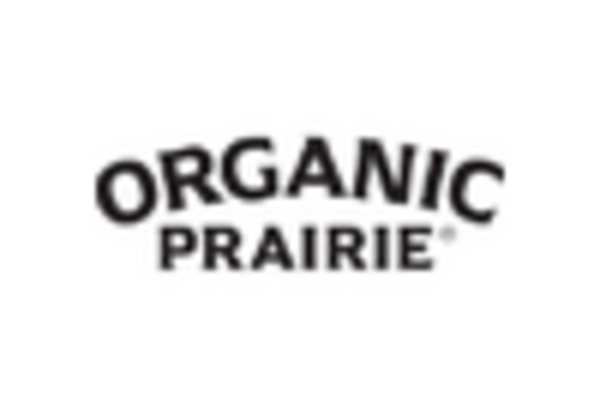The Organic Beef Meat Market is currently characterized by a dynamic competitive landscape, driven by increasing consumer demand for sustainably sourced and organic products. Key players such as Tyson Foods (US), Cargill (US), and JBS (BR) are actively shaping the market through strategic initiatives that emphasize innovation and sustainability. Tyson Foods (US) has been focusing on enhancing its organic product line, while Cargill (US) is investing in supply chain transparency to meet consumer expectations. JBS (BR), on the other hand, is expanding its organic beef offerings in response to growing market demand, indicating a collective shift towards more sustainable practices among these major players.
In terms of business tactics, companies are increasingly localizing manufacturing and optimizing supply chains to enhance efficiency and reduce environmental impact. The market appears moderately fragmented, with a mix of large corporations and smaller, niche players. This structure allows for a diverse range of products and strategies, as key players leverage their scale to influence market trends while smaller companies often focus on specialized offerings that cater to specific consumer preferences.
In August 2025, Tyson Foods (US) announced a partnership with a local organic farm network to enhance its supply chain for organic beef. This strategic move is significant as it not only strengthens Tyson's commitment to sourcing locally but also aligns with consumer preferences for transparency and sustainability in food sourcing. By collaborating with local farms, Tyson aims to ensure a consistent supply of high-quality organic beef, which could enhance its competitive positioning in the market.
In September 2025, Cargill (US) launched a new initiative aimed at improving traceability in its organic beef supply chain. This initiative is crucial as it addresses growing consumer concerns regarding food safety and ethical sourcing. By implementing advanced tracking technologies, Cargill is likely to bolster consumer trust and differentiate its products in a crowded marketplace, thereby reinforcing its market presence.
In July 2025, JBS (BR) expanded its organic beef production facilities in Brazil, a move that reflects its commitment to meeting the rising demand for organic products. This expansion is strategically important as it positions JBS to capitalize on the increasing global appetite for organic beef, particularly in emerging markets. By enhancing its production capabilities, JBS is likely to improve its market share and operational efficiency.
As of October 2025, the Organic Beef Meat Market is witnessing trends that emphasize digitalization, sustainability, and the integration of advanced technologies such as AI in supply chain management. Strategic alliances among key players are increasingly shaping the competitive landscape, fostering innovation and collaboration. Looking ahead, it appears that competitive differentiation will evolve from traditional price-based competition to a focus on innovation, technology adoption, and supply chain reliability, as companies strive to meet the changing demands of consumers.


















Leave a Comment